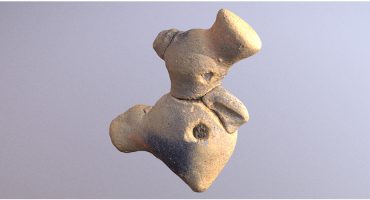Our Cultural institutions Page highlights our ongoing support of museums and cultural institutions with free accounts and access to tools. In Cultural Heritage Spotlight, we’ll explore museums and cultural institutions who are using 3D technology to bring new life to their collections. Today’s blog post features Museo Virtual Alto de La Cruz‘s amazing work in Spain.
Archaeological sites at Cortes (Navarra, Spain): key to a time of changes
The town of Cortes is placed at the Southern end of the region of Navarra, on the river Ebro. Three thousand years ago, this was a strategic location of fertile land, plentiful water, kind weather and easy trackways through broad plains. Besides, the formerly rich iron deposits at the Moncayo mountains provided excellent conditions for settlements.
At the end of the 1940’s, near the confluence between the rivers Ebro and Huecha, new discoveries announced a yet unknown ancient town. Archaeological excavations were carried out during the 1950’s, 1980’s and beginning of 1990’s, revealing important information about a period of the Prehistory that was poorly represented in Spain: the final Bronze Age and the early Iron Age.
Thorough research on these findings have been interpreted and re-interpreted. What was initially considered the proof of Indo-European migrations from Central Europe is nowadays seen as the entrance of cultural influences from the “urnenfelder” cultures from the continent through the Iberian North-East and their spread along the Ebro valley. Deep technological changes that meant for pre-existing native population, major transforms to all their means of life and social and economic structures (including the use of iron). This evolution would lead to the better known Celtiberian cultures that Romans contacted at the end of the 1st millenium BC.
The will of a town to recover its History
These long and exhaustive archaeological surveys produced invaluable scientific knowledge and tons of materials. However, the standards about the treatment of this Heritage were not the same as they are nowadays, and the people of Cortes have always regretted the fact that nothing of this could be really seen at their village. The sites themselves –both the settlement at the Alto de La Cruz and the linked cemetery at La Atalaya- were covered in order to be protected, and all the pieces were moved to several Museums and warehouses.
At the same time, Cortes has a fantastic castle, initially built in the Middle Age and deeply remodelled along the Modern Age. The local authorities have developed a praiseworthy labour to recover the building, despite last years’ economic difficulties, by mobilising voluntary work and funding from the people themselves. In a very intelligent way, the town hall team thought up the idea to link both lines and designed a project to install a permanent physical local museum for goods from the Iron Age of Cortes at the castle.
The virtual link
In order to “shake” the minds of all the agents that might be involved in such a project –people, academic instances, regional government and institutions- searched for a way to revitalise the curiosity about this Heritage that could be carried out in a fast, cheap and easy way. This problem was solved by new technologies on 3D Photogrammetric Scan and the possibility to present and spread them on the web -thank to 3D websites, and specially Sketchfab and the facilities this site provides to upload and share.
The Town Mayor, Conchi Ausejo, and the Councillor of Culture, Mª Jesús Ozco took this project as a personal bet and contacted Pablo Serrano Basterra, responsible of the Virtual Sketchfab Museum of the Roman City of Los Bañales. The agreement was fast and the documentation, selection, scanning and uploading started immediately.
 Photo-scanning a small clay pot at the warehouse of the Archaeology Section of Navarra at Cordovilla.
Photo-scanning a small clay pot at the warehouse of the Archaeology Section of Navarra at Cordovilla.This is the origin of the Museo Virtual Alto de La Cruz. The 14th October 2016, it was officially presented at Cortes. Week after week, new 3D models of selected pieces are added and spread –mainly via our Facebook fanpage. The selection of the pieces and the review of texts and annotations has been leaded by Prof. Glòria Munilla Cabrillana, from the Universitat Oberta de Catalunya, who was in charge of the last investigation and excavation program in the 1990’s.
Conclusion (not really, we expect)
We pretend this to be a starting point that –we hope- will finally involve many other people and institutions, and will encourage other actions. Virtual recreation of the settlement is on its way, and the physical museum at the Castle seems to be closer, but… Why not, maybe, even a new investigation stage in the future? Meanwhile, we are proud to “socialise” this interesting pieces of Heritage that could not be in any other way visited.
And we are thankful to the extraordinary Sketchfab team, whose bet in favor of culture allows us to make real –virtually real- the beginning of this project.
Thanks again for sharing, Pablo!
If you are part of a cultural institution, get in touch with us at museums@sketchfab.com to set up your free business account.






